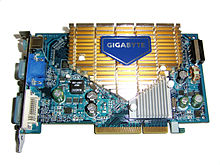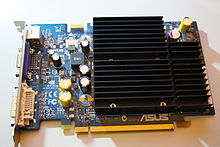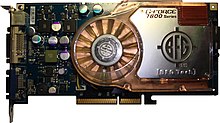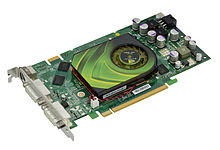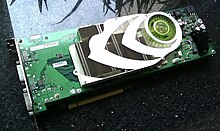GeForce 7 series
Although the 7300 LE was originally intended to be the "lowest budget" GPU from the GeForce 7 lineup, the 7100 GS has taken its place.
As it is little more than a revamped version of the GeForce 6200TC, it is designed as a basic PCI-e solution for OEMs to use if the chipset does not have integrated video capabilities.
NVIDIA GeForce 7200 GS desktop Graphics Processing Unit was launched in January 2006.
The GPU uses Second Generation CineFX Shading architecture, and it is manufactured on 90 nm technological process.
The GPU supports PCI Express 1.0 interface, and needs a single motherboard slot.
The GeForce 7500 LE is an OEM GPU and is identical to the 7300 GS based on the G72 core.
[6] This series was available with AGP and PCI-Express interfaces, covering a wide range of market segments.
In addition to the standard GeForce 7 series features, the 7600 series supports following advanced features: On March 22, 2006, Nvidia announced the immediate availability of the GeForce 7600 GS GPU targeted at the low-mid end.
It was made to provide a GeForce 7 series card to the mass market; some companies released AGP versions.
The 7800 series was designed to deliver exceptional performance and was targeted towards the high-end market segment.
The GeForce 7800 GTX (codenamed G70, and previously NV47) was the first GPU in the series, launched on June 22, 2005 with immediate retail availability.
The GeForce 7800 GTX supported the highest specification DirectX 9 vertex and pixel shaders, at the time: Version 3.0.
The PlayStation 3's Reality Synthesizer is based on the 256 MB model of the 7800 GTX, but with slight modifications.
The card features a much improved core clock speed of 550 MHz vs. 430 MHz (27.9% increase) and fast 1.1 ns GDDR3 memory clocked at 1.7 GHz vs. 1.2 GHz (41.7% increase), when compared to the original version.
Like ATI's X1800 XT, the addition of another 256 MB of memory, and to a lesser extent, the increased clock speeds, have raised the heat and power output significantly.
To combat this, the GeForce 7800 GTX 512 sports a much larger yet quieter dual slot cooling solution when compared to the original 256 MB version.
Officially, this series was meant to support mainly PCI Express Interface but some companies released also AGP versions.
[16] The referenced MSI customer notice has been changed to remove explicit references to woot!.
At stock memory speeds, most comparisons found the GTO to lag behind the GTX by roughly a 5-10% margin.
The majority of owners find that their GTO will overclock to 1600 MHz memory speeds, despite the under-volted RAM.
The GTO was an extremely popular card among enthusiasts as it offered near GTX performance at a considerably lower price.
It was a limited production card aimed at cleaning out G70 inventories before the release of the G80, and only spent about a month in retail channels before selling out.
[19] This is not like products such as the ASUS Dual GeForce 7800 GT or nVidia's own 7950 GX2, where two GPUs are on the same card.
Many issues in this implementation of a dual-GPU unit convinced Nvidia to restrict its sale to OEM companies.
Two of the cards operating in quad-SLI also required extremely well designed airflow to function, and demanded a 1000 watt power supply unit.
Officially, this series was meant to support only PCI Express Interface but some companies released AGP versions.
This card is designed for the DIY market; it addresses many problems which the previous 7900 GX2 had suffered from, such as noise, size, power consumption, and price.
According to some review sites (such as Tom's Hardware - see above), a single 7950GX2 draws less power than a single ATI Radeon X1900 XT – some consider this an amazing feat considering the GX2 employs a pair of GPUs, when the Radeon uses only one.
Other review sites say that a GX2 is quieter than the aforementioned Radeon,[23] despite the GX2 boasting a pair of identical GPU coolers – however 'loudness' is highly subjective without the proper tools and testing conditions.
[citation needed] On August 9, 2006, Nvidia released initial ForceWare 91.45 drivers for Windows 2000 and XP that support Quad SLI.



